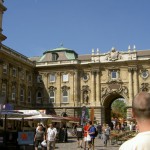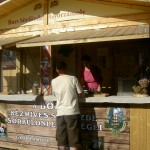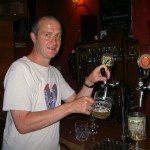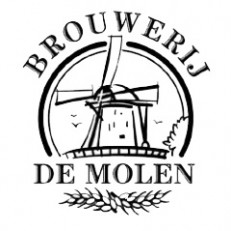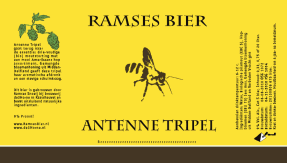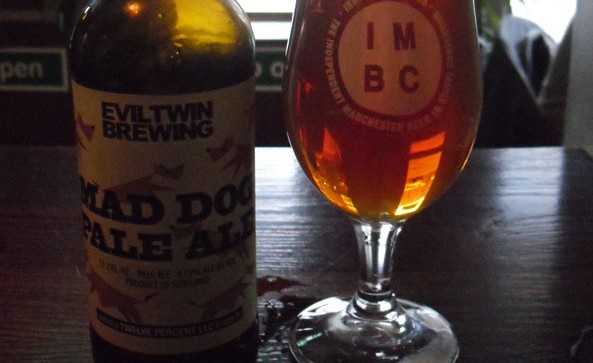
– Review: Evil Twin – Mad Dog Pale Ale by Niall Lecoustre
As the craft beer revolution gathers pace more and more good beer is reaching British shores from Scandinavia. Mikkeller set down the benchmark for quality craft beer from the region releasing ground breaking beers such as Beer Geek Breakfast, an exceptional Oatmeal stout. Others followed such as Nogne and Haandbryggeriet from Norway and Hornbeer and Evil Twin from Denmark. Some of these breweries are really hard to come by in the UK but thankfully Port Street are sourcing more and more gems from the area.
Evil Twin comes from particularly good beer stock being the brainchild of the brother of the man behind Mikkeller. Like Mikkeller, Evil Twin is a gypsy brewer, brewing his beers at such luminaries of the beer world as De Molen and Brewdog. Evil Twin states that his mission is to disturb, cause disorder and enlighten drinkers with his beers. I would go further and say Evil Twin are making beer fun with such ridiculously named beers as ‘The Talented Mr Orangutan’ and ‘Christmas Eve in a New York City Hotel Room’.
Despite the crazily named beers Evil Twin shouldn’t be dismissed and considered a novelty brewer as he is making great stuff. Probably the most interesting Evil Twin beer to date has been the Imperial Taiji, (recently renamed simply as Yin and Yang) a combination of Yin, an exceptional imperial stout and Yang a super hopped double IPA. The combination of the two beers created a moreish hoppy stout which works incredibly well. Both beers were brewed at Brewdog like the latest Evil Twin offering at Port Street, Mad Dog Pale Ale.
Mad Dog is an easy drinking offering from Evil Twin and is a good introduction to the brewery. It doesn’t have the high ABV of Ying and Yang but is still packed with flavour and is unique in its own right. It pours pale amber and has a nice slightly frothy white head. The aroma is light and hoppy with both floral and fruit notes which hint at the tastes to come. Upon tasting, first the sweetness comes to the fore and there are clear hints of citrus fruits and spices. When the sweetness subsides it is replaced by a long, bitter finish which will definitely meet with the approval of hop heads. Mad Dog doesn’t fit the stereotype of the typical American Pale Ale and is surprisingly bitter for such a low strength beer. It is a nice starting point for exploring the Evil Twin Range before trying the big hitters such as Yin and Yang and some of the magnificent imperial stouts which the brewery is producing. I have tried some of the breweries stouts and haven’t been disappointed yet. Even More Jesus, the latest Imperial Stout from the brewery is definitely on my to-drink list next time I’m in Port Street.
If you haven’t tried any offerings from Evil Twin, give them a go. You will not be disappointed.
Brewer: Evil Twin
Brew: Mad Dog Pale Ale
Style: Pale Ale
ABV: 4.7 %
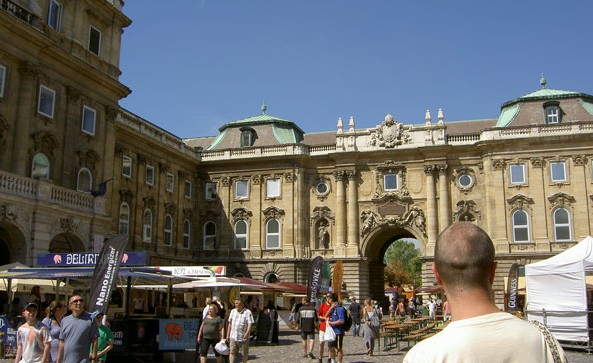
– Budapest beer explorations by Niall Lecoustre
When people think of Hungary they think of amazing architecture and possibly good wine but certainly not beer. Hungarians keep most of their best wine for the domestic market and don’t seem to export their beer. By chance my visit to Hungary coincided with the Sorfesztival, a celebration of Hungarian mainstream and craft beer, also offering some decent stuff from Belgium, Germany, the Czech Republic and even Brewdog. The majority of Hungarians seem to drink lager and dunkel style beers but under the surface there is a growing interest in craft beer and small breweries are experimenting with less traditional styles.
The Sorfesztival (29 Aug- 2 Sep) took place in the spectacular location of Budapest castle, east of the river Danube in the Buda part of the city. The castle was worth exploring and its courtyards provided an ideal backdrop for the beer festival. Each brewery had its own wooden stall with the majority serving draft beer and the odd one offering bottles. So was the beer any good? Well the majority was pretty average but one or 2 offerings were worth seeking out. Armando Otchoa runs the beer shop Csak a Jo Sor (Only good beer) and his Grabanc IPA was supposed to be available at the festival. Despite searching every inch of the courtyard, disappointingly I couldn’t track it down. When I met Armando a few days later he informed me that his latest batch wasn’t ready for the festival and would only be available after I had left town! I started the festival with Sefforas IPA; the first IPA brewed in Hungary and a pretty flat, watery affair on this showing. Next up was Koleses Sor, a pale, refreshing beer ideal for the hot weather.
The festival took a turn for the better with a visit to the Bors brewery stand. Despite all their beers being bizarrely named after characters from Robin Hood, they certainly seemed to make some of the more interesting craft beers available in Hungary. On draft Little John pale ale was a bit cloudy but still had plenty of flavour. The bottle version was even better, a bit yeasty with nice hints of fruit. Tuck Barat a Belgian style double, was a tasty, well-balanced affair with hints of caramel and dark fruit. The Bors brewery is still a work in progress but they are definitely a brewery worth watching and their beers are well worth trying. Next, the Gyertyanos Kriek was a nasty cherry beer best avoided. This was followed by Buza from Szeles and Szeles, an instantly forgettable wheat beer sold in plastic bottles by the likeable brewer.
The beer of the festival and probably the best Hungarian craft beer of the trip was Keseru Mez brewed by Foti. This was a well-balanced, honeyed beer with fruit notes and a subtle hop bite which was quite moreish. It was popular with the locals in Skanzenclub and also came in decent 500ml bottles. The Sorfestival cost £7 including a couple of beers and was an enjoyable affair and a good introduction to Hungarian craft beer. It also provided a chance to wander round the grounds of the fantastic castle. The Hungarian scene is still in its infancy but a couple of breweries have the potential to up their game and enter the export market. Budapest does have some great bars worth visiting to escape the generic mass produced lagers that dominate the city. Csak a Jo Sor is a small but excellent beer shop/pub run by the knowledgeable Armando. The shop sells some of the best Hungarian beer and also has a good selection of craft beer from heavyweights including De Molen, Brewdog and Flying Dog at very reasonable prices. The fruit beers from the Bekesszentandrasi brewery were definitely worth trying, especially the plum beer which was extremely refreshing after traipsing round in the hot summer sun. Other places worth checking out in Budapest include Skanzenclub, Bier Beer, Piratos Pub and the IF Café. Skanzenclub in particular was really fun. It is an unlicensed pub which doubles as a tobacco museum where you pour your own pint and pay for it in a collection tin. The bar served really good draft Kesuru Mez and the local crowd were very friendly. Budapest is certainly a great city to visit and although the Hungarian craft beer scene is very much a work in progress, if you search around you might find something worth drinking.
Words by Niall Lecoustre
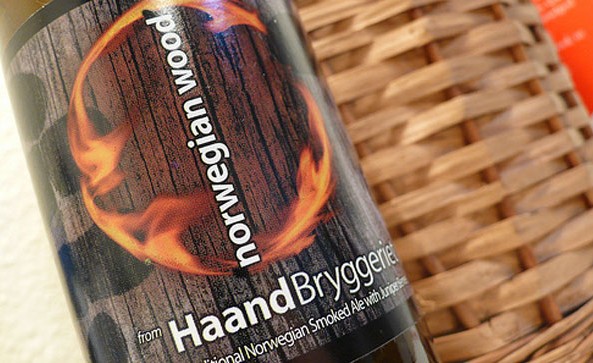
– Review – Haandbryggeriet Norwegian Wood / By DJ Adams
Haandbryggeriet – what a mouthful, and we haven’t even got to the name of the brew yet! Actually, when you break it down, this name is from two Norwegian words and simply translates to “Hand Brewery” – in other words, an extremely small scale operation. Four guys, working on a voluntary basis, brewing by hand in a small building in Drammen, southwest of Oslo. At this scale, and with the enthusiasm that oozes from the pages of their modest website, it’s clear that the brewers are fantastic amateurs, in the original, complimentary sense of the word – working the brewery for the love of it. (If you’re curious about this reclaiming of the word ‘amateur’, read Paul Graham’s essay “What Business Can Learn From Open Source” here: http://paulgraham.com/opensource.html)
For a small operation, Haandbryggeriet has certainly produced a wide range of beers – from a wheat stout called “Dark Force”, through an Akevitt barrel aged porter, to a hop-free Gruit beer made with herbs, brewed as a guest beer in cooperation with the de Molen bewery.
Norwegian Wood is a Haandbryggeriet beer available at Port Street Beer House on tap, and is brewed all year round. It’s a traditional Norwegian beer that has been recreated in memory of the farm brews that abounded when old laws required them to produce ale (farms were sometimes confiscated and went to the church and the king if they didn’t). In fulfilling their requirements, the farms usually kilned the malt over an open fire, giving each brew a smokiness that has been recreated here. The brew was enhanced with the traditional spice for all Norwegian beer at the time – juniper. The juniper spice comes not only from the berries themselves, but also from the twigs that are placed in the mash tun.
So many miles and years away from these traditional Norwegian farms, I sit here with a serving of Norwegian Wood. As I observe the hazy copper colour and the fading creamy head, there’s an intense aroma of pine and smokiness. Not an unpleasant or strong smokiness, but something more subtle, akin to pipe tobacco. There’s a taste of pine and a hint of cooked juniper berries, and rather than smoky, the flavour is more nutty and slightly sticky sweet, with an undercurrent of charcoal or cinder. The first sips also had a fruitiness about them but towards the bottom of the glass this had been replaced with a decent hint of malt that was very pleasant.
Haandbryggereit brews Norwegian Wood with smoked malt from Germany, along with other malts including crystal and chocolate. There’s a wealth of aromas and flavours in a small glass of this traditional ale, and the smokiness is by no means the dominant feature. I wouldn’t describe myself as a fan of smoked beer in the classic “Rauchbier” sense, but I definitely would order this again. With pine, hazelnuts, juniper and cinder in there, this beer is not only a mouthful to pronounce, but a very pleasant mouthful to enjoy.
Brewer: Haandbryggeriet
Brew: Norwegian Wood
Style: Traditional Ale
ABV: 6.5%
Words by DJ Adams www.pipetree.com/qmacro/
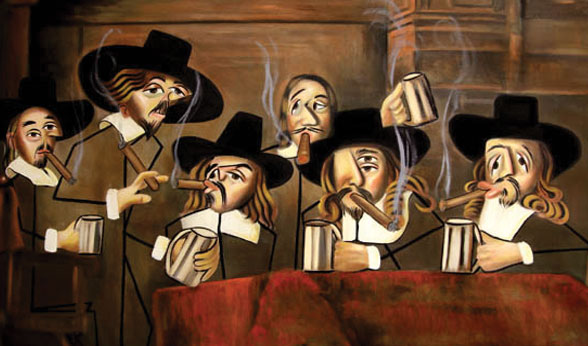
– Dutch Masters / By Jon Clarke
Hands up who can name some Dutch breweries and beers. Heineken? Check. Grolsch and Amstel? Check. La Trappe? Probably. De Molen? If you are reading this – almost certainly. And then?
Today the Netherlands is the home to some of the best beer brewed in Europe, produced by an increasing number of innovative micro brewers and beer firms (who either borrow another brewery or contract out their beers). But, to quote Michael Cain, “not many people know that”. First, a little bit of history.
Sandwiched between Belgium and Germany you might think that the Netherlands may have a long history as a centre of traditional and quality brewing. In fact it’s brewing history in the second half of the 20th Century resembles most closely that of the USA. Thus by about 1980 the Dutch brewing industry was reduced to one giant firm (Heineken – which also owns the Amstel brands) and less than 20 independent breweries, all making large quantities of adjunct ridden industrial pilsner and little else.
There were perhaps two glimmers of light in the general gloom. In the south of the country the monastery at Koningshoeven was making what are now branded as La Trappe beers and there remained the annual Bokbier tradition of strong dark autumnal beers (of which a bit more later). However, the worldwide brewing revolution didn’t pass the country by and from about 1980 onwards a trickle of microbrewers opened up. Unfortunately many of these produced wannabe Belgian-style beers which rarely matched the originals in either quality or finesse. Post production quality control left a lot to be desired as well.
Fast forward to 2011 and the scene is rather different. Heineken still dominates the market of course, and the number of independent family brewers has continued to decline. Most of the first wave micros have departed the scene, too. However there are now almost 130 breweries and beer firms, many of which are producing increasingly impressive beers in a whole range of styles. One word of warning though – in common with every country that has a burgeoning micro brewing scene, there are a fair few breweries making resoundingly dull beer; and quality control can still be an issue even for some breweries that have now been around long enough to know better. With that proviso here are a few breweries whose products are worth seeking out:
De Molen – based in Bodegraven between Leiden and Utrecht, “The Mill” is based under a windmill sited next to a canal. Just how Dutch is that? Menno Olivier is the head brewer and his beers already feature at PSBH. The best beers are the imperial stouts and big IPAs. The first imperial stout from De Molen was Rasputin (10.7%) and this, along with the wonderful Tsarina Esra imperial porter (11%), remain De Molen’s signature beers.
Emelisse – in the far south, the Grand Café Emelisse has emerged as one of the best new Dutch brewers in the past few years. New beers flow thick and fast and all are of the highest quality. The draft Black IPA (8%) was one of the highlights of the foreign beer bar at the 2011 Great British Beer Festival. Espresso Stout (8%) is superbly accomplished, as is the Imperial Stout (11%) and the recent Blond (6.8% and laden with New Zealand hops). Barrel aged imperial stouts and barley wines are also increasingly seen along with excellent Double and Triple IPAs.
De Schans – one of the older established micros, based at Uithoorn near Schipol airport since 1997. Guus Roijen has built an enviable reputation for the consistency of his beers and in the past couple of years has started to expand his range with several new and experimental offerings. The hoppy, spicy Saison (7%) has long been, and remains, a personal favourite Dutch beer. The Triple (8%) has been revamped and is now hopped only with Nelson Sauvin, as is the new Saison Ambree (7%) Also check out the Imperial Stout (8.5%) and the contract brewed Van Vollenhoven’s Extra Stout (7%).
De Eem – based in Amersfoort, Ruud van Moorst has been borrowing other brewer’s kit to make his excellent beers since 2006. Notable are the single hop IPAs – the oddly named Rosebud (6.7%) is hopped with Centennial, while Chinook (7.3%) and Warrior (4.6%) speak for themselves.
Ramses – another beer firm making an exceptional range of beers. Antenne Tripel (9%) includes local honey to give an aromatic nose while the generous use of American hops gives a firm, bitter base. Shire Stout (8.4%) is a complex wonder with vanilla, coffee and juniper berries in the mix, while Hop is a big 6.5% single hopped IPA using Pacific Gem hops from New Zealand. Others in the wide and impressive range include Den Dorstige Tiger, another big 6.6% IPA and Mamba Porter (6.4%) described as an American Porter with Amarillo, Chinook and Crystal hops in the grist.
Jopen – for many years Jopen commissioned their beers from the Proef Brewery in Belgium but last year opened the Jopenkerk in Haarlem – a hugely impressive conversion of an old church building into a gleaming state of the art brew pub. Among the newer beers are Trinitas Tripel (9%), a spicy and hoppy interpretation of the style (one of the best tripels made in the Netherlands in my opinion), and the mighty Ongelovige Thomas, described as an “imperial quadruple”. This 11% monster is more a triple IPA as it comes with huge hop character from the use of Simcoe, Chinook and Cascade hops
And this is just the tip of the iceberg. There’s really no space to more than name check other rising stars such as De Prael, Duits & Lauret, Praght, Christoffel (check out the hoppy 8.7% Nobel) and Pelgrim (whose draft Amarillo Tripel is one of my beers of the year).
Finally – a quick word about Bokbiers. Almost every Dutch brewer makes at least one of these dark, strong (minimum 6.5%) autumn beers, traditionally launched every October. A good place to try them is the annual Bokbier Festival, held on the last weekend of October at the Beurs van Berlage – on the Damrak right in the middle of Amsterdam and this year featured no fewer than 75 Dutch bokbiers. As ever it was something of a mixed bag but for me there seemed to be a steep change in overall quality this year – hopefully reflecting the great strides being made in the wider Dutch brewing scene, ironically though one of the stars was brewed by a Brit. Steve Gammage has been in the Netherlands for about 30 years but is now making some stunning stuff at Brouwerij Rodenburg. His Bronkhorster Dubbelbock, generously hopped with Cascade, Sovereign and Nelson Sauvin was a perfect marriage of traditional beer style with new wave brewing.
So there you go. The Dutch beer scene – one of the rising stars but one of the best kept secrets in European brewing. Proost!
Words by John Clarke / Chariman of South Manchester CAMRA and Editor of Opening Times
